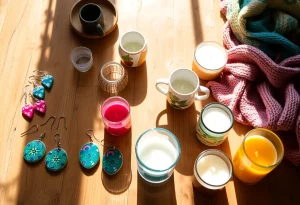Table of Contents
Understanding Etsy’s Marketplace
Etsy started as a small online marketplace for crafters in 2005. Today, it’s a global powerhouse for unique, handmade, and vintage items. With over 90 million active buyers, Etsy has become the go-to place for shoppers seeking one-of-a-kind products.
What sets Etsy apart from other e-commerce platforms? Its focus on creativity and individuality. Unlike mass-produced goods found on Amazon or eBay, Etsy celebrates artisans and their craft. This unique positioning attracts a specific type of shopper.
Let’s look at who shops on Etsy:
- Mostly women (81% of buyers)
- Aged 18-35 (primary demographic)
- Values uniqueness and sustainability
- Willing to pay more for handmade items
Etsy’s success comes from connecting these buyers with sellers who offer:
- Handcrafted goods
- Vintage items (20+ years old)
- Craft supplies
- Digital products
Here’s how Etsy stacks up against other platforms:
| Feature | Etsy | Amazon | eBay |
|---|---|---|---|
| Focus | Unique & handmade | Everything | New & used goods |
| Seller type | Mostly individuals | Mix of individuals & businesses | Mix of individuals & businesses |
| Fees | Lower | Higher | Varies |
For sellers, Etsy offers a platform to turn passion into profit. But success on Etsy requires understanding what sells best. Let’s explore that next.
Check out this video for some quick tips on finding winning Etsy products:
As you dive into selling on Etsy, managing orders across multiple channels can get tricky. That’s where tools like Marketplace Connect come in handy, helping you keep track of inventory and orders across platforms.
Top-Selling Etsy Categories for 2024
Etsy shoppers are always on the hunt for unique, handmade items. This year, a few categories are really taking off. Let’s look at what’s hot right now:
- Handmade jewelry and accessories: People love one-of-a-kind pieces
- Personalized and custom gifts: Think engraved items or custom portraits
- Home decor and furnishings: Cozy throw pillows and wall art are big
- Art prints and digital downloads: Easy to produce and ship
- Eco-friendly and sustainable products: Shoppers care about the planet
These categories are booming because they offer something special you can’t find in big box stores. Buyers are willing to pay more for items that feel personal and unique.
This video shows a quick way to find best-selling products on Etsy. It’s a great starting point if you’re not sure what to sell.
Choosing Profitable Products for Your Shop
Picking the right products can make or break your Etsy shop. Here’s how to choose items that will sell:
- Research market demand and competition
- Calculate profit margins and set smart prices
- Consider how long it takes to make each item
- Use your unique skills to stand out
- Check Etsy’s search analytics for trends
It’s not just about what’s popular. You need to find a sweet spot between what sells well and what you’re good at making. This balance is key to long-term success on Etsy.
When looking at potential products, ask yourself:
- Can I make this item consistently?
- Is there room for me in this market?
- Does this product fit with my brand?
- Can I price it competitively and still make a profit?
Remember, it’s okay to start small and grow. Many successful Etsy sellers began with just a few products and expanded over time. The key is to start with quality items that you can produce reliably.
Optimizing Your Etsy Listings for Success
Creating a great product is just the first step. To really succeed on Etsy, you need to make your listings shine. Here’s how:
| Element | Why It Matters | Tips |
|---|---|---|
| Product Title | Helps buyers find your item | Use keywords, be specific |
| Photos | Shows off your product | Use good lighting, multiple angles |
| Description | Gives details buyers need | Be clear, highlight features |
| Price | Affects buyer decisions | Research competitors, factor in costs |
| Tags | Improves search visibility | Use all 13 tags, be relevant |
Good photos are crucial. They’re often the first thing a buyer sees. Take clear, well-lit pictures that show your product from different angles. If possible, include a photo of the item in use.
Your product description should answer any questions a buyer might have. Be detailed but not wordy. Use bullet points to highlight key features. And don’t forget to mention things like size, materials, and care instructions.
Pricing can be tricky. You want to make a profit, but you also need to be competitive. Research similar items to see what others are charging. Don’t forget to factor in your time and materials when setting prices.
Managing all these details across multiple platforms can be a challenge. That’s where tools like Marketplace Connect come in handy. It helps keep your inventory and orders synced across different sales channels, saving you time and reducing errors.
By focusing on these key areas, you can create Etsy listings that catch buyers’ eyes and turn browsers into customers. Remember, success on Etsy is about more than just having great products. It’s about presenting them in the best possible light.
Maximizing Sales Across Multiple Channels
Etsy sellers looking to boost their revenue often find success by expanding to additional marketplaces. This strategy opens up new customer bases and diversifies income streams. However, managing multiple sales channels comes with its own set of challenges.
Key benefits of multi-channel selling:
- Increased visibility and reach
- Reduced dependence on a single platform
- Opportunity to test different markets
- Potential for higher overall sales volume
While the benefits are clear, sellers must navigate the complexities of inventory management and order fulfillment across platforms. Without proper tools, this can quickly become overwhelming.
- Inventory sync issues
- Overselling risks
- Increased time spent on admin tasks
- Difficulty tracking performance metrics
To address these challenges, many sellers turn to integration tools like Marketplace Connect. This type of solution streamlines operations by automating inventory updates and centralizing order management. The result? More time to focus on product development and marketing strategies.
Key features to look for in a multi-channel management tool:
- Real-time inventory syncing
- Unified order dashboard
- Automated listing creation
- Cross-platform analytics
By leveraging these tools, sellers can make data-driven decisions about which products perform best on each platform. This insight allows for targeted strategies to maximize sales across all channels.
Ultimately, successful multi-channel selling requires a balance of strategic planning and efficient execution. With the right approach and tools, Etsy sellers can significantly expand their reach and boost their bottom line.
Your Path to Etsy Success Starts Now
So there you have it – a rundown of some hot products to consider selling on Etsy this year. From handmade jewelry to vintage finds, there are tons of options to explore. The key is finding that sweet spot between what you’re passionate about creating and what shoppers are eager to buy.
Remember, trends come and go. What’s popular now might not be next month. That’s why it’s smart to keep an eye on what’s selling well and be ready to adapt. Maybe test out a few different product types to see what clicks with your target customers.
Whether you’re just starting your Etsy shop or looking to boost an existing one, now’s the time to take action. Pick a product category that excites you, do some market research, and start creating or sourcing inventory. With some hard work and creativity, you could be on your way to Etsy success.
And hey, if you’re also selling on other platforms like Shopify, tools like Marketplace Connect can help streamline things by syncing your inventory across channels. That way you can focus more on making great products and less on juggling multiple storefronts.
Ready to dive deeper? Check out the FAQ section below for answers to some common questions about selling on Etsy.
Common Questions About Selling on Etsy
How much does it cost to start an Etsy shop?
Opening an Etsy shop is free. You’ll only pay fees when you list items and make sales. Each listing costs $0.20 and lasts for four months or until the item sells. When you make a sale, Etsy takes a 6.5% transaction fee plus payment processing fees.
Can I sell both handmade and vintage items?
Yes, Etsy allows you to sell handmade goods, vintage items (at least 20 years old), and craft supplies. You can mix and match these categories in your shop, giving you flexibility to diversify your product offerings.
How do I handle shipping for my Etsy products?
Etsy provides tools to help you manage shipping. You can set up shipping profiles for different types of items, use calculated shipping based on package weight and dimensions, or offer flat rate shipping. Many sellers use Etsy’s built-in shipping label service to save time and money.
What tools can help me manage my Etsy business?
Etsy offers built-in tools for inventory management, order processing, and analytics. For sellers expanding to multiple platforms, tools like Marketplace Connect can help sync orders and inventory across Etsy and other channels, streamlining your operations as you grow.
How can I make my Etsy listings stand out?
Use high-quality photos, write detailed descriptions, and use relevant tags to improve visibility. Offer excellent customer service, encourage reviews, and consider Etsy’s advertising options. Regularly updating your shop with new items can also boost your visibility in search results.
Is it possible to run an Etsy shop as a side hustle?
Absolutely. Many Etsy sellers start as part-time entrepreneurs. You can set your own pace and scale your business as time allows. Just be sure to manage customer expectations regarding processing and shipping times, especially if you’re balancing your shop with other commitments.





